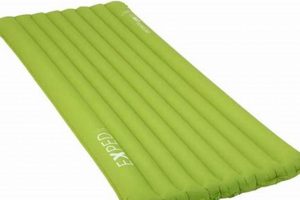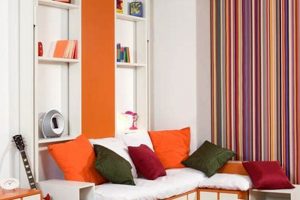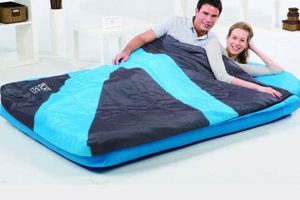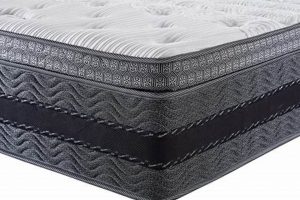A component of convertible seating furniture, the sleeping surface within a queen-sized pull-out couch can be exchanged to improve comfort or address wear. These replacements typically involve removing the existing mattress and installing a new one designed to fit the specific frame dimensions of the sofa bed. For example, a worn or uncomfortable innerspring mattress in a sleeper sofa might be replaced with a memory foam alternative.
The condition of this particular component significantly impacts the overall user experience of a convertible sofa. A quality replacement can enhance sleep quality and extend the lifespan of the furniture. Historically, these replacements were often limited to innerspring options, but advancements in material technology have broadened the selection to include foam, gel-infused foam, and even air mattress alternatives. This offers consumers greater control over the firmness and support of their sleep surface.
The subsequent sections will delve into factors to consider when selecting a suitable option, including mattress type, dimensions, thickness, and the practical aspects of the installation process. The goal is to provide information that allows informed decisions regarding the maintenance and improvement of convertible seating furniture.
Essential Considerations for Replacing a Queen Sleeper Sofa Mattress
Optimal selection and installation are crucial for a successful enhancement of convertible seating comfort. The following recommendations aim to guide the decision-making process.
Tip 1: Determine Accurate Dimensions: Prior to purchase, precisely measure the interior frame of the sleeper sofa when fully extended. These dimensions dictate the acceptable length, width, and thickness of the replacement, ensuring proper fit and functionality of the folding mechanism.
Tip 2: Evaluate Mattress Type Based on Usage: Consider the frequency of use. For occasional guest accommodations, a standard innerspring or thinner foam mattress may suffice. For regular use, prioritize denser memory foam or hybrid options offering enhanced support and durability.
Tip 3: Assess Thickness Limitations: Sleeper sofa mechanisms often impose thickness restrictions. Exceeding the recommended maximum thickness can hinder folding and storage. Consult the sleeper sofa’s documentation or manufacturer specifications for optimal thickness ranges.
Tip 4: Prioritize Breathability and Cooling Properties: Overheating can detract from sleep quality. Opt for materials with enhanced breathability, such as gel-infused memory foam or mattresses with integrated ventilation channels. These features promote airflow and temperature regulation.
Tip 5: Verify Compatibility with Folding Mechanism: Certain mattress types, particularly those with high density or inflexible construction, may impede the smooth operation of the folding mechanism. Consider lighter, more pliable materials to avoid stress on the hardware.
Tip 6: Inquire About Warranty and Return Policies: Before finalizing a purchase, review the warranty terms and return policies. This provides recourse in the event of manufacturing defects, unexpected discomfort, or incompatibility with the existing sleeper sofa frame.
Tip 7: Consider Professional Installation Assistance: If unfamiliar with furniture disassembly and reassembly, consider engaging a professional installer. This mitigates the risk of damage to the sleeper sofa frame or the new mattress during the installation process.
Adherence to these guidelines will help to ensure a successful exchange, contributing to an improved sleeping experience and extended lifespan of the convertible furniture.
The subsequent sections will discuss the maintenance of replacement mattresses to further increase its life.
1. Dimensions Accuracy
The precise measurement of a sleeper sofa frame is a prerequisite for selecting a replacement mattress, ensuring both operational functionality and user comfort. Discrepancies in dimensions can lead to a host of problems, compromising the intended use of the convertible furniture.
- Operational Impairment
An oversized mattress can impede the folding mechanism, preventing complete closure and potentially damaging the frame. Conversely, an undersized mattress may shift during use, creating uncomfortable gaps and reducing support. These issues can shorten the lifespan of both the sofa bed and the replacement sleeping surface.
- Compromised Comfort
Dimensional inaccuracies directly affect the sleeping experience. A mattress that is too short will not provide adequate support for the legs, while one that is too narrow will restrict movement and create a sense of confinement. Consistent discomfort can negate the benefits of replacing the original mattress.
- Frame Stress and Wear
Forcing an oversized mattress into the frame places undue stress on the folding mechanism, potentially leading to premature wear or breakage. Constant pressure on specific points can weaken hinges and supports, requiring costly repairs or even rendering the sofa bed unusable. This is especially true of older or less robust sleeper sofa designs.
- Voided Warranties
Installation of a mattress with incorrect dimensions may void warranties on both the sleeper sofa and the replacement mattress. Manufacturers often stipulate that products be used as intended, and improper fit constitutes misuse. Consequently, consumers may be responsible for repair costs arising from dimensional errors.
Therefore, accurate measurement and adherence to manufacturer specifications are essential when selecting a replacement mattress for a queen sleeper sofa. Neglecting this step can lead to operational problems, compromised comfort, accelerated wear, and potential warranty issues. Careful attention to dimensions is a fundamental aspect of responsible sleeper sofa maintenance.
2. Material Density
Material density, in the context of a queen sleeper sofa mattress replacement, refers to the mass per unit volume of the mattress components, typically foam. This property directly impacts the support, durability, and overall comfort provided by the mattress. Higher density materials generally offer greater resistance to compression, resulting in enhanced support and a longer lifespan. For instance, a memory foam mattress with a density of 5 pounds per cubic foot will typically offer superior support and durability compared to a similar mattress with a density of 3 pounds per cubic foot. The impact of material density on a sleeper sofa mattress is significant due to the inherently thinner profile of these mattresses compared to standard bed mattresses. The limited thickness necessitates the use of higher density materials to compensate for the reduced volume, ensuring adequate support and preventing premature sagging.
The selection of an appropriate material density for a queen sleeper sofa mattress replacement should be guided by the intended frequency of use and the weight of the users. For occasional use by lighter individuals, a medium-density foam may be sufficient. However, for regular use or for heavier individuals, a high-density foam is advisable to maintain support and prevent premature wear. The practical significance of understanding material density extends to cost considerations as well. Higher density materials are generally more expensive, but their increased lifespan can offset the initial cost over time. Conversely, opting for a lower density mattress may result in more frequent replacements, ultimately increasing the overall expense. It is essential, therefore, to balance cost considerations with the expected performance and longevity of the replacement mattress.
In summary, material density is a critical factor in determining the quality and suitability of a queen sleeper sofa mattress replacement. It directly influences support, durability, and overall comfort. An informed decision regarding material density, considering factors such as frequency of use, user weight, and cost, is crucial for ensuring a satisfactory and long-lasting sleeping experience. The challenge lies in balancing these factors to achieve the optimal combination of performance, durability, and affordability. Understanding this connection is important for maintaining the sleeper sofa mechanism.
3. Thickness Limitations
Thickness limitations are a defining constraint in the context of queen sleeper sofa mattress replacements. Sleeper sofa mechanisms, designed for folding and storage, impose a strict maximum thickness on the mattress. Exceeding this limit prevents proper closure of the sofa, potentially damaging the frame and rendering the furniture unusable as intended. The folding hardware, hinges, and internal support structures are calibrated to accommodate a specific mattress profile, usually significantly thinner than a standard bed mattress. For instance, a sleeper sofa designed for a 5-inch mattress cannot reliably fold with a 7-inch replacement. This restriction necessitates careful consideration of mattress thickness as a primary selection criterion during the replacement process. The effect is a constrained market of mattress choices, requiring buyers to prioritize compatibility over personal comfort preferences to a degree.
The practical significance of understanding thickness limitations lies in avoiding costly errors and ensuring the functionality of the sleeper sofa. Ignoring the manufacturer’s specifications can result in the purchase of an unusable mattress, leading to return hassles and potential restocking fees. Moreover, forcing an oversized mattress into the frame can gradually stress the folding mechanism, leading to premature failure of hinges, supports, and other critical components. For example, regularly attempting to close a sleeper sofa with an incompatible mattress can cause the metal frame to bend or crack, necessitating extensive repairs or even complete replacement of the furniture. Professional consultations are often recommended to mitigate risks related to incorrect mattress dimensions.
In summary, thickness limitations represent a fundamental constraint that must be meticulously considered when replacing a queen sleeper sofa mattress. This requirement influences the selection process, necessitates adherence to manufacturer guidelines, and directly impacts the functionality and lifespan of the furniture. While it limits mattress choices, respecting thickness limitations is essential for preventing damage, ensuring proper operation, and maximizing the investment in both the mattress and the sleeper sofa itself. Furthermore, this understanding extends to warranty considerations, as using an incompatible mattress can void manufacturer guarantees.
4. Support Structure
The support structure within a queen sleeper sofa mattress replacement is a critical determinant of both comfort and longevity. Its composition and design directly influence the sleeping experience and the overall durability of the mattress. Effective support mitigates sagging, promotes proper spinal alignment, and distributes weight evenly across the surface. The following details the facets of this critical component.
- Innerspring Systems
Innerspring systems utilize interconnected or individually wrapped coils to provide support. The gauge and configuration of the coils dictate the firmness and responsiveness of the mattress. A higher coil count generally translates to enhanced support and reduced motion transfer. For example, a Bonnell coil system offers basic support, while pocketed coils conform more precisely to the body’s contours. The innerspring design must withstand repeated folding and unfolding within the sleeper sofa mechanism.
- Foam Core Density
Foam core mattresses rely on varying densities and types of foam to provide support. High-density foams resist compression and maintain their shape over time, preventing sagging and providing a stable sleeping surface. Memory foam conforms to the body, relieving pressure points, while high-resilience foam offers a more responsive feel. Layering different foam types allows for customized support and comfort levels. The foam’s ability to recover its shape after compression is crucial for sleeper sofa applications.
- Edge Support Reinforcement
Edge support reinforcement enhances stability around the perimeter of the mattress, preventing roll-off and maximizing the usable sleeping surface. This is particularly important in sleeper sofa mattresses, which often have a limited sleeping area. Edge support can be achieved through the use of firmer foam encasements or strategically placed metal supports. Robust edge support also contributes to the structural integrity of the mattress during folding and unfolding.
- Weight Distribution Design
Effective weight distribution minimizes pressure points and promotes proper spinal alignment. Mattress designs often incorporate zoned support, with firmer materials in areas that support the hips and shoulders and softer materials in areas that support the back and legs. This targeted approach enhances comfort and reduces the risk of discomfort or pain. Proper weight distribution is essential for preventing sagging and maintaining the mattress’s shape over time, especially under the concentrated weight of a sleeper.
These facets demonstrate that the support structure is integral to the performance of a queen sleeper sofa mattress replacement. The specific choice of support system depends on individual preferences, budget constraints, and the intended frequency of use. However, prioritizing a robust and well-designed support structure ensures a comfortable and durable sleeping surface within the constraints of the sleeper sofa mechanism. Furthermore, the type of support structure impacts the long-term viability and maintenance requirements of the overall convertible furniture.
5. Folding Mechanism Compatibility
The successful integration of a replacement mattress into a queen sleeper sofa is fundamentally dependent on its compatibility with the folding mechanism. The design and operational parameters of the mechanism dictate the acceptable dimensions, weight, and flexibility of the mattress. A mismatch in these attributes can cause operational failure, damage the furniture, and render the sleeper function unusable. For example, a mattress that exceeds the specified thickness may prevent the sofa from closing completely, placing undue stress on the frame and hinges. Conversely, a mattress that is too rigid may impede the folding process, potentially causing the mechanism to bind or break. The long-term functionality of the sofa bed is thus directly linked to ensuring that the replacement mattress adheres to the compatibility requirements of its integrated mechanism.
The practical significance of folding mechanism compatibility extends to user safety and furniture longevity. A poorly matched mattress can create unstable sleeping surfaces, increasing the risk of falls or injuries. Moreover, forcing an incompatible mattress into the folding mechanism can gradually weaken the hardware, leading to premature wear and the need for costly repairs. Consider a scenario where an innerspring mattress with improperly positioned coils interferes with the mechanism’s pivot points; the resulting friction could lead to metal fatigue and eventual breakage. Therefore, meticulous attention to manufacturer specifications and, when available, professional consultation during mattress selection is crucial for maintaining the safety and operational integrity of the sleeper sofa.
In conclusion, folding mechanism compatibility is not merely a technical detail but a pivotal factor in the successful and safe operation of a queen sleeper sofa with a replacement mattress. Understanding the relationship between the mattress characteristics and the mechanism’s requirements is essential for preventing damage, ensuring user safety, and maximizing the lifespan of the furniture. The inherent challenges in balancing comfort preferences with mechanical constraints underscore the need for informed decision-making and, potentially, expert advice when selecting a replacement mattress for a sleeper sofa.
6. Warranty Terms
Warranty terms are a critical consideration in the selection and purchase of a queen sleeper sofa mattress replacement. These legally binding agreements outline the manufacturer’s responsibility for defects in materials or workmanship, providing recourse for the consumer in the event of product failure. Understanding the scope and limitations of these terms is essential for protecting one’s investment and ensuring long-term satisfaction.
- Coverage Period and Scope
The coverage period defines the duration for which the warranty remains in effect, typically ranging from one to ten years, or even longer for premium products. The scope specifies the types of defects covered, which may include sagging beyond a certain threshold, structural failures, or manufacturing flaws. For example, a warranty might cover indentation greater than 1.5 inches but exclude damage caused by misuse or improper cleaning. Consumers must carefully review these stipulations to understand their rights and responsibilities. Note that prorated warranties often decrease the amount covered over time.
- Exclusions and Limitations
Warranty agreements invariably contain exclusions and limitations, which specify conditions under which the warranty is voided. Common exclusions include damage resulting from improper support, stains, burns, or alterations to the mattress. For example, using a queen sleeper sofa with a damaged or unsuitable folding mechanism may invalidate the mattress warranty. Furthermore, warranties typically do not cover comfort preferences, such as firmness or feel. It is imperative to understand these limitations to avoid unintentional warranty violations.
- Claims Process and Requirements
The claims process outlines the steps required to initiate a warranty claim, including documentation, inspection procedures, and repair or replacement options. Typically, consumers must provide proof of purchase, photographs of the defect, and a detailed description of the issue. The manufacturer may require an inspection to verify the claim. For example, a claim for sagging might necessitate measurements taken under specific conditions. Understanding the claims process streamlines resolution and ensures compliance with warranty requirements.
- Transferability and Subsequent Owners
The transferability clause dictates whether the warranty can be transferred to subsequent owners of the queen sleeper sofa mattress replacement. Many warranties are non-transferable, meaning they are valid only for the original purchaser. This limitation can impact the resale value of the furniture and influence purchasing decisions. For instance, a transferable warranty might increase the appeal of a used sleeper sofa, while a non-transferable warranty restricts its value to the original owner.
A comprehensive understanding of warranty terms empowers consumers to make informed decisions when selecting a queen sleeper sofa mattress replacement. By carefully reviewing the coverage period, exclusions, claims process, and transferability provisions, buyers can mitigate risk and ensure that their investment is adequately protected. Failure to consider these aspects can lead to unexpected expenses and dissatisfaction in the long term. Furthermore, warranty details should be easily accessible and clearly articulated by retailers to foster consumer confidence and trust.
Frequently Asked Questions
The following questions address common inquiries concerning the selection, installation, and maintenance of replacement mattresses for queen sleeper sofas.
Question 1: What mattress thickness is optimal for queen sleeper sofas?
The optimal mattress thickness is dictated by the sleeper sofa mechanism. Consult the manufacturer’s specifications for the maximum allowable thickness. Exceeding this limit may impede folding and damage the frame. Typically, thicknesses range from 4.5 to 5.5 inches for optimal functionality.
Question 2: What materials are most suitable for these replacements?
Suitable materials include high-density memory foam, gel-infused foam, and innerspring systems designed for folding. High-density foam provides superior support and durability. Gel-infused foam enhances temperature regulation. Select materials that balance comfort and compatibility with the folding mechanism.
Question 3: How does material density impact comfort and longevity?
Higher material density correlates with increased support and durability. Denser foams resist compression and maintain their shape over time, preventing sagging. For frequent use, prioritize mattresses with a density of at least 3 pounds per cubic foot.
Question 4: What factors should be considered when measuring for a replacement?
Measurements must be precise and taken with the sleeper sofa fully extended. Account for any internal frame components that may reduce the available space. Measure length, width, and thickness accurately to ensure a proper fit. It is recommended to measure at multiple points to account for any irregularities.
Question 5: Are specialized tools required for installation?
Specialized tools are typically not required for installation. However, a screwdriver may be necessary to detach and reattach any retaining hardware. Assistance from another individual is often recommended due to the weight and size of the mattress.
Question 6: How can the lifespan of the mattress be extended?
To extend the lifespan, utilize a mattress protector to guard against stains and spills. Regularly rotate the mattress to promote even wear. Avoid placing excessive weight or pressure on specific areas. Adhere to the manufacturer’s cleaning instructions to prevent damage.
Careful consideration of these factors will contribute to a satisfactory and long-lasting replacement experience.
The following section will provide a conclusion.
Conclusion
The preceding analysis has explored the critical aspects of queen sleeper sofa mattress replacement. Key considerations include dimensional accuracy, material density, thickness limitations, support structure design, folding mechanism compatibility, and warranty terms. Each element directly influences the comfort, durability, and functionality of the convertible furniture.
The informed selection of a replacement mattress is an investment in both the longevity of the sleeper sofa and the quality of rest it provides. Neglecting these factors can lead to premature wear, operational difficulties, and compromised user experience. Future advancements in materials and design may further enhance the performance and value of these components, underscoring the importance of staying informed about available options and best practices.





![Best Semi Truck Sleeper Mattress [Guide + Reviews] Organic & Natural Mattress Buyer’s Guide: Non-Toxic Sleep Solutions Best Semi Truck Sleeper Mattress [Guide + Reviews] | Organic & Natural Mattress Buyer’s Guide: Non-Toxic Sleep Solutions](https://mattressworldpa.com/wp-content/uploads/2025/07/th-1748-300x200.jpg)

